典型结构件的振动疲劳分析
- 格式:pdf
- 大小:1.57 MB
- 文档页数:70
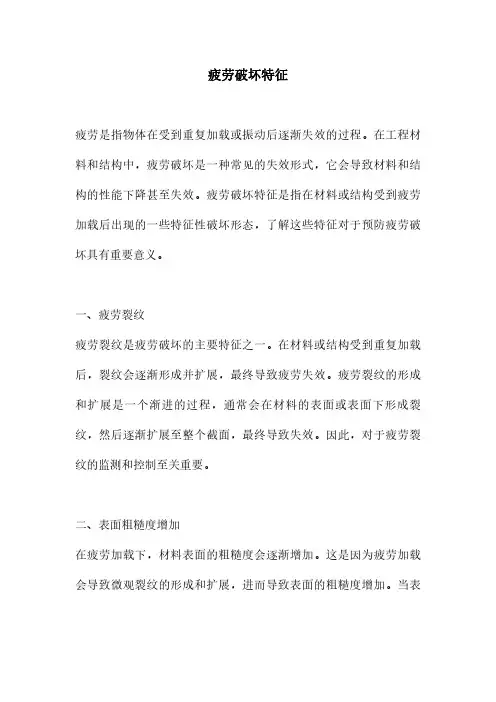
疲劳破坏特征
疲劳是指物体在受到重复加载或振动后逐渐失效的过程。
在工程材料和结构中,疲劳破坏是一种常见的失效形式,它会导致材料和结构的性能下降甚至失效。
疲劳破坏特征是指在材料或结构受到疲劳加载后出现的一些特征性破坏形态,了解这些特征对于预防疲劳破坏具有重要意义。
一、疲劳裂纹
疲劳裂纹是疲劳破坏的主要特征之一。
在材料或结构受到重复加载后,裂纹会逐渐形成并扩展,最终导致疲劳失效。
疲劳裂纹的形成和扩展是一个渐进的过程,通常会在材料的表面或表面下形成裂纹,然后逐渐扩展至整个截面,最终导致失效。
因此,对于疲劳裂纹的监测和控制至关重要。
二、表面粗糙度增加
在疲劳加载下,材料表面的粗糙度会逐渐增加。
这是因为疲劳加载会导致微观裂纹的形成和扩展,进而导致表面的粗糙度增加。
当表
面粗糙度增加到一定程度时,会导致应力集中和疲劳裂纹的形成,加剧了疲劳破坏的发展。
三、变形增加
在疲劳加载下,材料或结构的变形会逐渐增加。
这是因为疲劳加载会导致材料的塑性变形,进而导致变形增加。
随着变形的增加,材料或结构的强度和刚度会逐渐下降,最终导致疲劳失效。
综上所述,疲劳破坏特征包括疲劳裂纹的形成和扩展、表面粗糙度的增加以及变形的增加。
了解这些特征对于预防疲劳破坏具有重要意义,可以通过监测和控制这些特征来延缓疲劳失效的发生,提高材料和结构的使用寿命。


泵振动原因和测试与解决方法目录_Toc34896210总则 (3)振动评估 (3)泵的运行点对振动的影响 (4)泵入口设计对振动的影响 (5)平衡 (6)泵/驱动机对中 (6)共振 (7)转子动力学评估 (9)流体“增加质量”对转子动力学固有频率的影响 (10)环形密封“Lomakin效应”对转子动力学固有频率的影响 (10)转子扭转分析 (11)转子动力稳定性 (13)参数共振和分数频率 (15)测试方法– FFT频谱分析 (16)测试方法–冲击(敲击)测试 (17)振动故障排查 (19)案例:立式泵带空心轴/齿轮箱驱动 (22)总结 (24)总则当泵及其关联系统发生故障时,通常归结到四种类型:断裂,疲劳,摩擦磨损或泄漏。
断裂的原因是过载,例如超过预期的压力,或管口负荷超出推荐的水平。
疲劳的条件是施加的载荷是交变的,应力周期地超过材料破裂的耐久极限,泵部件的疲劳主要由振动过大引起,而振动大由转子不平衡,泵和驱动机之间轴中心线的过大不对中,或固有频率共振放大的过大运动引起。
摩擦磨损和密封泄漏意味着转子和定子之间的相互定位没有在设计的容差范围。
这可以动态发生,一般原因是过大的振动。
当磨损或泄漏位于壳体单个角度位置,常见的原因是不可接受的管口载荷量,及其导致的或独立的泵/驱动机不对中。
在高能泵(特别是加氢裂化和锅炉给水泵),另一个在定子一个位置摩擦的可能性是温度变化太快,导致每个部件由于随温度的变化,长度和装配不匹配。
有一些特定的方法和程序可供遵循,降低发生这些问题的机会;或如果发生了,帮助确定解决这些问题的方法,从而让一台泵保养的更好。
振动评估关于泵的振动和其它不稳定机械状态的诊断或预测,应包括如下评估:•转子动力学行为,包括临界转速,激励响应,和稳定性•扭转临界转速和振荡应力,包括起机/停机瞬态•管路和管口负荷引起的不稳定应力,和不对中导致的扭曲•由于扭振、止推和径向负荷导致高应力部件的疲劳•轴承和密封的稳态和动态行为•正常运行和连锁停机过程的润滑系统运行•工作范围对振动的影响•组合的泵和系统中的声学共振(类似喇叭)通常讨论的振动问题是轴的横向振动,即与轴垂直的转子动力学运动,然而,振动问题也会在泵的定子结构发生,如立式泵,另外振动也会发生在轴向,也可能涉及扭振。
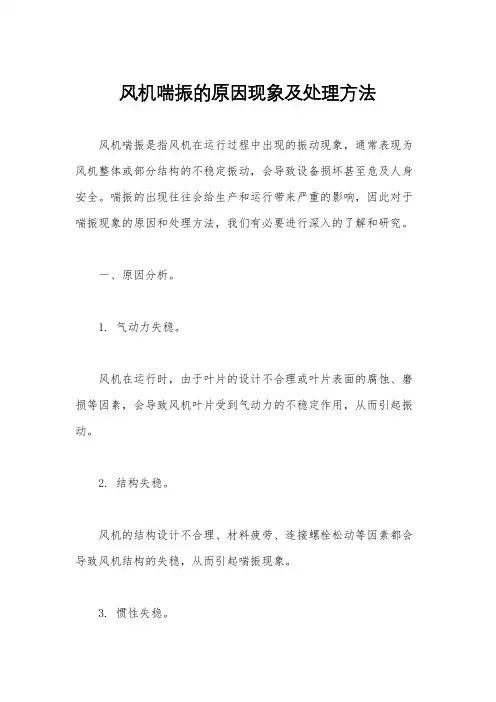
风机喘振的原因现象及处理方法风机喘振是指风机在运行过程中出现的振动现象,通常表现为风机整体或部分结构的不稳定振动,会导致设备损坏甚至危及人身安全。
喘振的出现往往会给生产和运行带来严重的影响,因此对于喘振现象的原因和处理方法,我们有必要进行深入的了解和研究。
一、原因分析。
1. 气动力失稳。
风机在运行时,由于叶片的设计不合理或叶片表面的腐蚀、磨损等因素,会导致风机叶片受到气动力的不稳定作用,从而引起振动。
2. 结构失稳。
风机的结构设计不合理、材料疲劳、连接螺栓松动等因素都会导致风机结构的失稳,从而引起喘振现象。
3. 惯性失稳。
风机在运行过程中,由于叶轮的不平衡或转子的不对称等因素,会导致风机的惯性失稳,从而引起振动现象。
二、现象表现。
1. 频率跳变。
风机在运行中,频率突然发生跳变,表现为振动频率明显变化,这是喘振现象的典型表现。
2. 声音异常。
风机在喘振时,会发出异常的噪音,通常是低频、深沉的嗡嗡声,这是喘振现象的另一种表现形式。
3. 振动幅值增大。
喘振时,风机的振动幅值会明显增大,甚至超出正常范围,这是喘振现象的直观表现。
三、处理方法。
1. 优化设计。
针对风机叶片和结构的设计不合理问题,可以通过优化设计来解决。
采用流场仿真、结构分析等技术手段,对风机进行全面的设计优化,提高风机的稳定性和抗振能力。
2. 定期检测。
针对风机结构的材料疲劳、连接螺栓松动等问题,需要定期进行检测和维护。
通过振动监测系统、结构健康监测技术等手段,及时发现并处理风机结构的失稳问题。
3. 动平衡调整。
针对风机惯性失稳问题,可以通过动平衡调整来解决。
对风机叶轮、转子等部件进行动平衡校正,提高风机的运行平稳性。
4. 加强管理。
在风机运行过程中,加强对风机的管理和维护,做好日常巡检和保养工作,及时发现并处理风机的异常现象,防止喘振现象的发生。
综上所述,风机喘振是一种常见的振动现象,其产生的原因复杂多样,需要我们对风机的设计、运行和维护进行全面的考虑和处理。
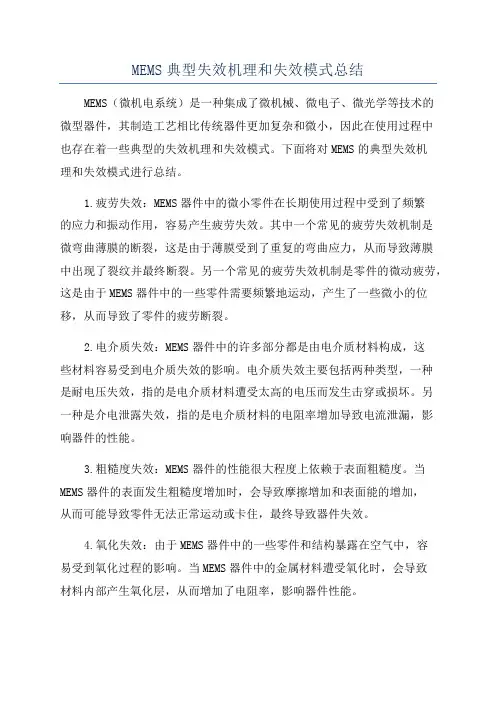
MEMS典型失效机理和失效模式总结MEMS(微机电系统)是一种集成了微机械、微电子、微光学等技术的微型器件,其制造工艺相比传统器件更加复杂和微小,因此在使用过程中也存在着一些典型的失效机理和失效模式。
下面将对MEMS的典型失效机理和失效模式进行总结。
1.疲劳失效:MEMS器件中的微小零件在长期使用过程中受到了频繁的应力和振动作用,容易产生疲劳失效。
其中一个常见的疲劳失效机制是微弯曲薄膜的断裂,这是由于薄膜受到了重复的弯曲应力,从而导致薄膜中出现了裂纹并最终断裂。
另一个常见的疲劳失效机制是零件的微动疲劳,这是由于MEMS器件中的一些零件需要频繁地运动,产生了一些微小的位移,从而导致了零件的疲劳断裂。
2.电介质失效:MEMS器件中的许多部分都是由电介质材料构成,这些材料容易受到电介质失效的影响。
电介质失效主要包括两种类型,一种是耐电压失效,指的是电介质材料遭受太高的电压而发生击穿或损坏。
另一种是介电泄露失效,指的是电介质材料的电阻率增加导致电流泄漏,影响器件的性能。
3.粗糙度失效:MEMS器件的性能很大程度上依赖于表面粗糙度。
当MEMS器件的表面发生粗糙度增加时,会导致摩擦增加和表面能的增加,从而可能导致零件无法正常运动或卡住,最终导致器件失效。
4.氧化失效:由于MEMS器件中的一些零件和结构暴露在空气中,容易受到氧化过程的影响。
当MEMS器件中的金属材料遭受氧化时,会导致材料内部产生氧化层,从而增加了电阻率,影响器件性能。
5.温度失效:MEMS器件在使用过程中容易受到温度变化的影响。
当器件暴露在高温环境下时,可能导致材料膨胀不均匀,从而使器件产生微小的形变,导致器件的性能下降或失效。
6.湿度失效:MEMS器件中的一些结构和材料容易与水分接触,从而受到湿度的影响。
当器件暴露在高湿环境下时,可能导致一些零件和连接薄膜变湿、膨胀或腐蚀,进而导致零件失效或材料失效。
总之,MEMS器件的典型失效机理和失效模式包括疲劳失效、电介质失效、粗糙度失效、氧化失效、温度失效和湿度失效。
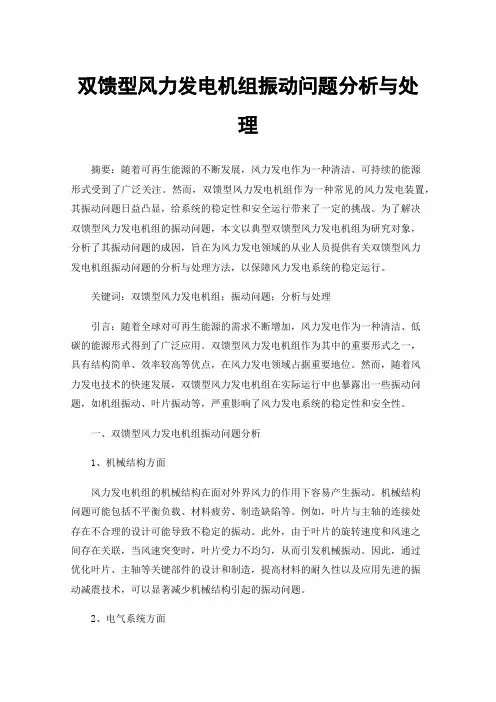
双馈型风力发电机组振动问题分析与处理摘要:随着可再生能源的不断发展,风力发电作为一种清洁、可持续的能源形式受到了广泛关注。
然而,双馈型风力发电机组作为一种常见的风力发电装置,其振动问题日益凸显,给系统的稳定性和安全运行带来了一定的挑战。
为了解决双馈型风力发电机组的振动问题,本文以典型双馈型风力发电机组为研究对象,分析了其振动问题的成因,旨在为风力发电领域的从业人员提供有关双馈型风力发电机组振动问题的分析与处理方法,以保障风力发电系统的稳定运行。
关键词:双馈型风力发电机组;振动问题;分析与处理引言:随着全球对可再生能源的需求不断增加,风力发电作为一种清洁、低碳的能源形式得到了广泛应用。
双馈型风力发电机组作为其中的重要形式之一,具有结构简单、效率较高等优点,在风力发电领域占据重要地位。
然而,随着风力发电技术的快速发展,双馈型风力发电机组在实际运行中也暴露出一些振动问题,如机组振动、叶片振动等,严重影响了风力发电系统的稳定性和安全性。
一、双馈型风力发电机组振动问题分析1、机械结构方面风力发电机组的机械结构在面对外界风力的作用下容易产生振动。
机械结构问题可能包括不平衡负载、材料疲劳、制造缺陷等。
例如,叶片与主轴的连接处存在不合理的设计可能导致不稳定的振动。
此外,由于叶片的旋转速度和风速之间存在关联,当风速突变时,叶片受力不均匀,从而引发机械振动。
因此,通过优化叶片、主轴等关键部件的设计和制造,提高材料的耐久性以及应用先进的振动减震技术,可以显著减少机械结构引起的振动问题。
2、电气系统方面风力发电机组的电气系统也是振动问题的一个重要来源。
电气问题可能包括电机不平衡、电气控制失效、变频器调节不当等。
电机不平衡会引发旋转部件的震动,而电气控制失效可能导致机组无法正常启停,进而引发振动问题。
特别是在双馈型风力发电机组中,电气系统与机械系统之间存在复杂的耦合关系,电气问题往往会影响到机械系统的运行稳定性[1]。
因此,通过定期进行电机的动平衡校正,强化电气控制系统的监测与维护,确保电气系统的正常运行,是减少电气系统引起振动问题的关键措施之一。
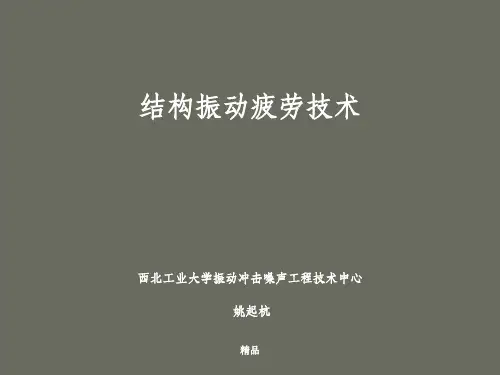
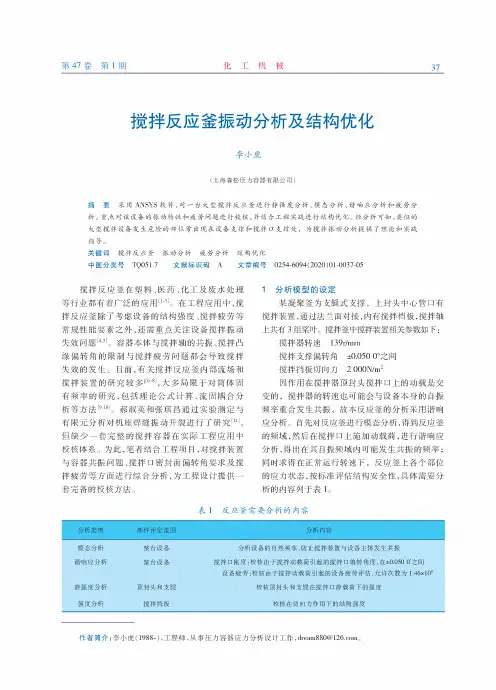

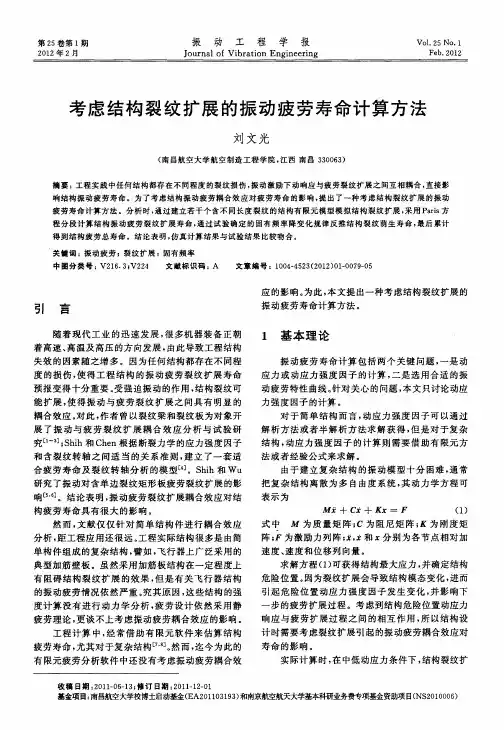

振动疲劳关键技术及其在底盘结构中的应用
毛显红;侯之超;宋立新;罗明军;赵永玲
【期刊名称】《汽车工程学报》
【年(卷),期】2013(003)002
【摘要】介绍了振动疲劳与静态疲劳与之间的基本概念,着重指出了二者之间差别.对求解静态疲劳问题的数值分析方法进行回顾,分析了静态疲劳分析方法对于振动疲劳问题的适用性.分析指出,静态疲劳分析方法,如果能够反映结构的振动特性,则可用于振动疲劳分析.最后结合对后扭力梁这种典型底盘结构振动疲劳问题的研究,从载荷识别、工作模态分析、动应力数值方法选择以及模态减缩的适用性等方面阐述了振动疲劳分析的若干关键技术.
【总页数】6页(P133-138)
【作者】毛显红;侯之超;宋立新;罗明军;赵永玲
【作者单位】清华大学汽车安全与节能国家重点实验室,北京100084
【正文语种】中文
【中图分类】U461.7+1
【相关文献】
1.车辆振动系统结构疲劳寿命预测方法及应用 [J], 吕澎民;赵邦华
2.结构疲劳因子在结构疲劳分析中的应用 [J], 吕立伟;王璞;赵耕贤
3.应变反求载荷方法在底盘件疲劳分析中的应用 [J], 汪谟清;沈磊
4.有限元仿真在振动结构疲劳分析中的应用 [J], 刘龙涛;李传日;马甜;乔亮
5.振动疲劳寿命分析在主镜支撑结构设计中的应用 [J], 余飞;吴清文;王宝石;邹艳;曲利新;黄涛;郑飞
因版权原因,仅展示原文概要,查看原文内容请购买。